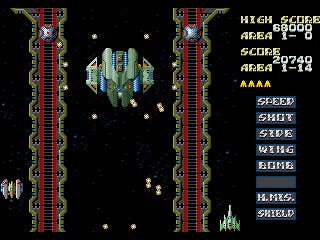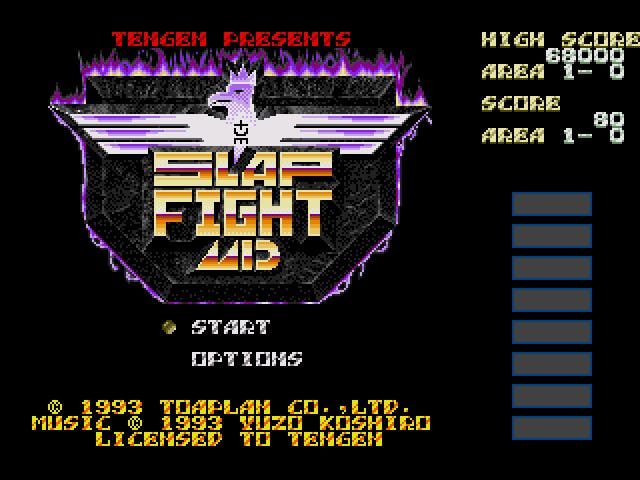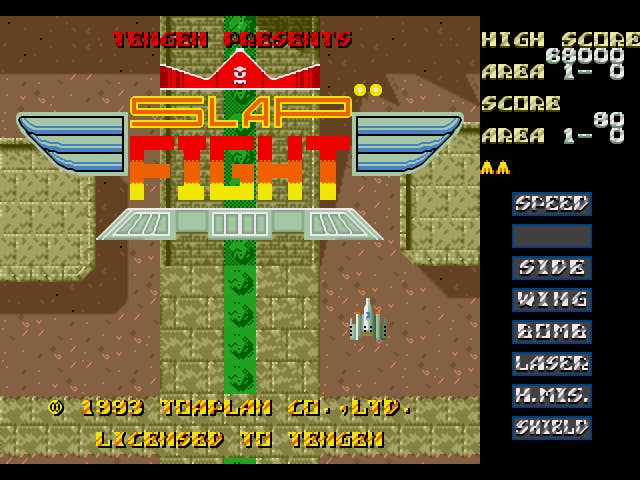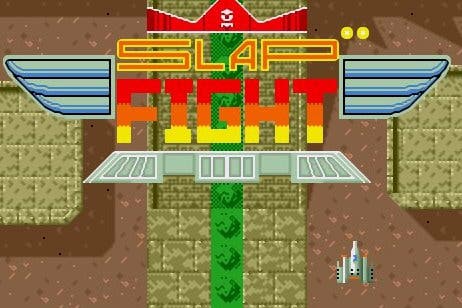Death from Above: The making of Slap Fight MD
Mikito Ichikawa takes us behind the doors of a forgotten classic.
Heavy metal murder on steel wings with a rack of laser-heated barrels, a die-cast ship comes screaming from a blackened fiery hue.
Now that's a cover.
Impressively Slap Fight MD, a Mega Drive port of Toaplan's 1986 arcade shooting game, does well to capture the death-from-above brutality of its promotional artwork. Publisher Tengen - a subsidiary of Atari's arcade division - infamously tried to circumvent Nintendo's NES security chip in the 80s to release unlicensed software, losing a string of lawsuits in the process. Although better known for bringing Atari arcade games to console, they hit a relatively unacknowledged sweet spot on Sega's Mega Drive in the early 90s with Gauntlet 4, Snow Bros and Slap Fight MD - and the latter is particularly fascinating.

Arriving on the Mega Drive seven belated years after its arcade debut and long after ports had already done the rounds on the ZX Spectrum, Atari ST, Amstrad and Commodore 64, Slap Fight MD was only released in Japan and South Korea, its print run a rumoured 5000 copies.
Yet, in-spite of its tepid launch, Slap Fight MD is not dissimilar to the limited edition releases of today, including both an excellent arcade translation with an additional arranged soundtrack, and an all-new, sequel-quality reimagining with a bespoke musical composition courtesy of Yuzo Koshiro.
In Slap Fight arcade, a top-down, vertical space-themed shooting game with a weapon system reminiscent of Gradius, you cycle through an å la Carte menu of weaponry by grabbing stars from smouldering potholes. The graphics are basic, clean and functional, its roaming droids, tubular corridors and boxy housing evoking a likeable 70s sci-fi aesthetic. The new 4:3 sculpturing is a tad squat compared to the vertical ratio of the arcade original, even with the heads-up display assigned to the right flank, but the top of the screen has been sensibly set as the play area's limit to ensure enemies aren't firing at you from out of nowhere.
Opening in natural terrain not dissimilar to Namco's Xevious, it fast evolves into harder space styling. There are no stages as such, just one long progression punctuated by several boss encounters, your progress measured in the HUD by a counter that moves through 80 areas before the game loops.
A game considered highly influential in shaping Toaplan's hallmark style and the manic 'bullet hell' shoot-em-ups they would catalyse with titles like Grind Stormer and Batsugun, Slap Fight's chief gimmick is bolstering your craft with wing attachments to increase your preferred weapon's range. You can upgrade three times, but what you gain in power is lost in flexibility. Ramping up your speed greatly increases your agility, but flying around with a wingspan that covers nearly a third of the screen is a recipe for disaster.
While the standard shot is incredibly effective, many secret bonuses can only be revealed with specific weapons. As programmer Masahiro Yuge explained in an interview for the Toaplan STG Chronicle music collection, this was to help the player learn which weapons were best for combating particular sections and enemies.
Purists unhappy with the port's added auto-fire (allowing you to point-blank most bosses into oblivion) can revert to the classic tap-shot via the option screen. A simultaneous three-button press in the same menu will also reveal Toaplan Mode, returning the ship's shield to the arcade's tougher 25 second timeout property while also allowing you to toggle the starting loop - a godsend for anyone who wants to hone their skills without starting over.
Slap Fight may be one of the easiest counter stops going, the challenge only marginally intensifying through loops one to eight before resetting on the ninth, but it remains a fantastic poster child for early Toaplan. Both tense and adrenaline-fuelled, increasingly aggressive bullet arrangements form a well-pitched difficulty curve that requires you to hit each phase of the loop with unwavering conviction.

In 1993, when the Mega Drive was hitting its technical zenith, those uninspired by score chasing may have incorrectly considered Slap Fight primitive compared to shooting games relatives like Gleylancer, Musha Aleste and Thunder Force 4 - likely the reason it ended up crammed with so many extras. And, for all the arcade port's excellence, it's Toaplan's revisionist Slap Fight MD that rules the cart, sitting awkwardly tucked away, as it does, in the option screen menu.
Designed exclusively for Sega's console and deservingly headlining the package, MD has all-new graphics and better-formed screen parameters, making navigation more buttery, and your ship has been transformed from diminutive spacecraft to angular angel of death.
A unique experience marked by Yuzo Koshiro's blistering audio - a selection of tracks that move from peppy and upbeat to do-or-die resolve - MD is about violence. Once bitten you'll be throttling into boss fights to the cry of "Terminate the flagship!" with a sudden taste for blood.
MD's makeover isn't just graphical, but strategic. Unlike vanilla Slap Fight, where wing attachments are a dangerous and irreversible gamble, MD allows you to detonate them as smart bombs, reducing your ship size in a fiery whirlwind that cuts through enemies and displaces loose stars. Not only does slamming wings on at select moments provide a window of invincibility through bullet streams, but with pragmatic menu management you can destroy one pair and instantly attach another. Taking advantage of this feature allows you to bomb aggressively and regularly; and in a design masterstroke you can even blow your default wings off in last-ditch desperation, reducing you to a tiny warship with an optimum advantage for bullet dodging. Think steel matryoshka doll layered with C4 and you're along the right lines.
Even with the threat of rank, a common shooting game instrument used to adjust the difficulty in response to the player's skill - or in this case, how many armaments you're packing - Slap Fight MD isn't overly challenging, allowing you to clear its 83 area loop in only ten minutes and head into the next primed for faster fire. With more variables than Slap Fight arcade you're constantly evaluating new tactics to better economise your stars and seek out hidden bonuses, making for an enticing scoring experience counterpart to a shooting game of streamlined clarity, Koshiro's bassline resonating harder with every quick-witted escape and chiming life extension.
Finding out who takes the credit for Slap Fight MD, and how much involvement Toaplan - who went bust just one year after its release - had in its conception is no mean feat. But in a twist of eleventh hour fortune a thread of investigative emails lead to Mr. Mikito Ichikawa, who also goes by the professional pseudonym Albert Micky. Founder of MNM games (now Mindware) and chief supervisor of Slap Fight MD, he was enthusiastic to talk to us about the game's development.
Mr. Ichikawa, how did you get into video gaming?
I used to buy arcade PCBs (Printed Circuit Boards) from distributors, just to disassemble and learn. I was also a hardcore gamer. When I was in high school I began working as a programmer for a game company called Dempa Micomsoft [well regarded in the 80s for their superb X68000 arcade ports] the first company to port Xevious.
When Slap Fight MD came to the Mega Drive, the arcade game was already seven years old. Can you tell us about how Slap Fight MD came to be, and did Tengen have any direct involvement in getting the game made?
The first time I met Tatsuya Uemura from Toaplan was at the home of the late Fukio Mitsuji, the famous game designer of Bubble Bobble. We exchanged our business cards, but it was about two weeks later that I stumbled completely by chance upon the Toaplan office in the second floor of a supermarket building! I loved Kyuukyoku Tiger (Twin Cobra overseas), so I decided on the spot to ask them if they'd let me do the console port. Uemura told me, "Kyuukyoku Tiger is already being ported by another company, but will you port Slap Fight for us?"
It was a surprise to me because Slap Fight in the arcade had the Taito logo; I didn't actually know it was a Toaplan game. But as someone who loved Slap Fight I happily accepted the offer. I remember clearly that we signed the contract within two weeks of me visiting their office.
Tengen was only the publisher and did not have any influence in the development of the game, but I was shocked to learn that Toaplan went bankrupt shortly after Slap Fight MD's release. I called Mr. Uemura, who was one of my most important contacts, and he said that his office phone would soon be shut down and gave me his home phone number instead. To this day we remain close friends.
I understand you became very ill after developing Streets of Rage 2 (Bare Knuckle 2 in Japan). Was this due to the difficulty of the project? And how did it affect your work on Slap Fight MD a few months later?

While I was in the middle of developing Bare Knuckle 2 in the fall of 1992, I was told I didn't have much longer to live. I had been incredibly busy from spring of that year, concurrently developing 4 games including Slap Fight MD. I was over working. The disease greatly affected the development of Slap Fight MD. By winter of 1992 I could not go to the office. I had to take my work PC home and direct development from there. By spring of 1993 I could no longer leave my bed. I was just waiting for death. Because of my deteriorating condition I didn't even know which version of the game would make it to market, and that prompted me to include version information in the game from that point onward.
The cover art for the game is particularly beautiful. Do you remember who the artist was, or have any information about the design process?
A company called Parsley Promotion did the cover art, and the head of this particular company had once introduced me someone high up in Taito. I happened to see the cover artwork in development in their office, but I have no idea about their design process.
Who was actually responsible for the design and creation of Slap Fight MD's Special Mode, and how much was Toaplan involved?
Tatsuya Uemura's last game is credited as Dogyuun one year earlier, but he appears on the producer credits for Slap Fight MD.
The name Jun Shimizu also appears prominently in the credits - what did he contribute to the game?
Ultimately, MNM Software developed Slap Fight MD on a sub-contract from Toaplan, and it was MNM Software that created the Special Mode (bar the sound design). But it was customary in the gaming industry to include the name of the original developer, and that's why Mr. Uemura's name appears in the credits. We would also meet once a week to discuss the game's progress. In the 80s Jun Shimizu published a Defrag program for the Sharp X68000, and was later a programmer at MNM Software. Apart from the sound driver he programmed the entirety of Slap Fight MD by himself and was also involved in the game's level design. You can find him credited in MaBoShi's Arcade, a game we (now Mindware) developed for Nintendo Wii in 2008. He is a highly skilled programmer, a superb gamer, and one of my mentors.
In the game you are credited with Sound Composition along with Yuzo Koshiro. I understand you and Mr. Koshiro were friends from high school. Did you get him involved in the Slap Fight MD project, and did you help with the musical arrangements?
Mr. Koshiro was graduating as I began my freshman year in the same high school. When I went to work at Dempa Micomsoft still wearing my high school uniform, Mr. Koshiro realised we were from the same school and spoke to me. I happened to be developing an RPG and asked him to do the music, to which he accepted right away. Since then we have been very close.
Mr. Koshiro had already provided many musical compositions for us at MNM by the time I asked him to do the music for Slap Fight MD, so he was a natural choice. Bare Knuckle 2 used a sound driver made by MNM, and I developed the sound driver and converted the sound for the Game Gear version of Shinobi.
For Slap Fight MD I arranged the sound for the Arcade Mode, made some FX for the Special Mode, and converted the sound data.
Actually, we weren't planning to make an original arrangement for the Arcade Mode's music, but Mr. Uemura said he wanted one. So I made a half-hearted attempt, secretly hoping he would give up on the idea in the early stages, but he happened to like it, forcing me to get serious and fully commit to the task!
Special Mode is really more than just a reimagining - it feels like a whole new game. What were your goals during the creative process?

We developed Special Mode because we were worried that if we followed Toaplan's basic contract to port Slap Fight arcade, the release would not have enough content.
We began thinking about an ultimate version of the game, one that had a wide range of strategic play. As a development team we felt the arcade version didn't offer enough variables.
I wanted many people, from 5 year-old kids to arcade maniacs, to play the game. So we decided to include a lot of content, and Special Mode was born from this process.
Slap Fight MD's new Typhoon Bomb system completely changes the game. Do you remember how this idea came to be?
The original arcade Slap Fight only had two buttons. In a meeting with Mr. Uemura he said "Let's utilise another button, since the Mega Drive has three buttons."
Many of Toaplan's games had a bomb function, so I came up with the idea of implementing a bomb in Special Mode.
I wanted to make every possible improvement over the arcade version of the game, while also lowering the difficulty slightly to make it more accessible. So for Special Mode, we didn't just make cosmetic changes to the map; we added a lot of special features. For example, in the original arcade version, the Homing weapon was too strong, so we fixed that. The Bomb weapon was extremely weak so we made that stronger, and also added way more hidden items to uncover when you use it. The Typhoon Bomb, which causes you to jettison one of your wings, was my idea, and I'm really fond of it. I added it as a way to greatly increase the player's strategic options.
The audio sample: "Terminate the flagship!" is one of Special Mode's most memorable additions. Who decided to add this and who provided the sample?
All the cool sound stuff was usually Mr. Koshiro's idea. I believe it was one of his friends in a US base in Japan that provided the sample. I think the sound FX for the power ups are pretty cool, too.
Your company Mindware have just developed a new shooting game - Super Chain Crusher Horizon - for Steam. It seems you're a fan of the shooting game genre. Can you counter stop Slap Fight MD?
I only achieved the counter stop in Arcade Mode. In Special Mode I made it to Area 6-70 on a single credit. I didn't usually play for score achievements, but enjoyed trying to play using only the bomb, or play using every available weapon. I did counter stop Toaplan's Twin Cobra and Flying Shark, however.
Super Chain Crusher Horizon is my first shooting game since Slap Fight MD, and its 2 player game design is strongly affected by Slap Fight MD's 2 player 'helper' mode.
Toaplan Mode is a big secret in Slap Fight MD, especially for purists who want to use the arcade's temporary shield and practice higher loops - but not many people know it exists! What was the thinking behind this?

It was one of Toaplan's strict instructions that the game would be playable by 5-year-old kids. However, we felt that to make the game truly great we needed to include options for hardcore gamers: so we hid them! Once we port a game, in the business sense, no other company can port it again, right? So we wanted to make sure we did our absolute best with the one chance we had.
Finally, did you face any significant challenges during Slap Fight MD's development?
If you take into account the cheaper price of a Mega Drive game, then the arcade conversion was really well done, but I can't say we were 100 per cent satisfied with it as developers. Toaplan gave us a lot of reference materials to help us with the development, but the graphic data for the arcade Slap Fight was originally made on an SMC-777 computer. This computer was top of the line for its day, capable of displaying 4096 colours. All the graphics data was stored on double density floppy disks, and made using Toaplan's own in-house software tools (unfortunately, they didn't give us any documentation for the data format this software used).
All the sprite editing and graphic work was done on the SMC-777. Toaplan's software tool could only create 8x8 sprites, so Toaplan had to draw and plot out the stage maps on graph paper, doing everything by hand, and using as few 8x8 sprites as possible. I was amazed when I learned that Slap Fight, which was known for its high quality graphics at the time, was made this way.
We had to figure out some way to read these SMC-777 disks, so we used a PC9801 computer and wrote a program that could read them. The arcade PCB had 16 palettes, but the Mega Drive only had 4. We created a converter that, through tiling, could make the graphics look the same as the arcade PCB even though there were fewer colours available on the Mega Drive. Through trial and error we eventually achieved a high-quality port.
Being my first time porting an arcade game to a console, what was supposed to take only 6 months ended up taking a full year. So I thought, "if the development is already this late, I might as well go ahead and include everything I wanted, and make my ideal version," so I just kept working and working on it.
Bottling Toaplan's signature mechanisms of motion, urgency, and bullet patterns you love to dodge, Slap Fight MD has you rolling the dice every time you attach an additional set of wings and subsequently ignite them, coasting on a razor edge of risk and reward. Despite the uncertain nature of its limited printing - and courtesy of a beautifully engineered console-only mode from unsung background contractors MNM Software - Slap Fight MD is the limited edition black label variant you never knew. Don't let the high price be an obstacle: just head to your bank and terminate your account.
Thanks to: Mikito Ichikawa (A.K.A Albert Micky) for his kind cooperation, DJ Katie Se7en for her translation assistance, and Blackoak of Schmuplations.com for source information and additional translation proof reading and editing.

